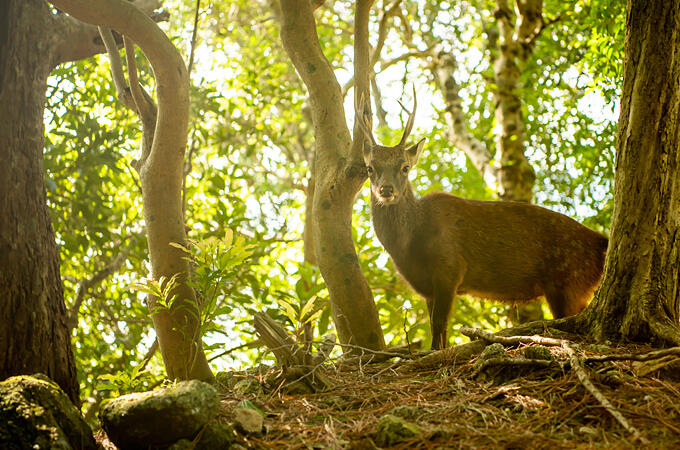More than 80 species of dwarf plants with stems and leaves shorter than 5 cm in length are distributed on Yakushima Island, a World Natural Heritage site. Why are these plants, which are normal in size in other places, extremely small only on this particular Island? Proposed theories include poor soil fertility, low temperature, and low solar radiation, but the actual cause remained unclear. A research team led by Specially Appointed Assistant Professor Daiki Takahashi and Professor Yoshihisa Suyama of the Graduate School of Agricultural Science at Tohoku University, Assistant Professor Shota Sakaguchi and Professor Hiroaki Setoguchi of Kyoto University, and Associate Professor Keitaro Fukushima of Fukushima University measured the size of 40 species of plants from Yakushima Island and their counterparts from outside the island to analyze factors related to plant body size. The results revealed that plant size reduction was related to whether the species was preferentially eaten by deer rather than weather conditions or soil nutrients. As deer are known to have difficulty eating extremely short plants, they thought that the dwarf plants of Yakushima Island evolved to evade the grazing pressure from Cervus nippon yakushimae. The work was published in the Journal of Ecology.

From 2020 to 2022, the research group selected and measured the size of 40 different plants comprising 30 preferable (palatable) and 10 non-preferable (unpalatable) species to C. nippon yakushimae, from the high-elevation area of Yakushima Island. For comparison, they also collected 40 plants distributed outside the island that were considered most closely related to each species. The results of measuring the stem height and leaf length of 1,908 individuals, including specimens, showed that for plants palatable to C. nippon yakushimae, plants on Yakushima were reduced in size to approximately one-half to one-tenth that of counterpart species outside the island, while there were no major differences in size between Yakushima and other regions for the unpalatable species. Furthermore, analyses that considered weather conditions, soil nutrients, and other factors at the collection sites also showed that the C. nippon yakushimae preference was most significantly related to differences in plant size compared to other factors.
Simulation analysis of the genome information of the Yakushima population and the counterpart population to estimate when they diverged revealed that many species diverged during the Last Glacial period when Yakushima Island was connected to Kyushu and Shikoku. This finding suggests that plant dwarfism occurred over tens of thousands of years, representing a relatively short time scale in evolution. These results suggest that the dwarf plants of Yakushima Island diverged from larger plants distributed in Kyushu and other areas during the Last Glacial period. Thereafter, individuals occurring in the Yakushima population were exposed to the strong grazing pressure from C. nippon yakushimae, and dwarf individuals of the population that were not grazed remained and spread in Yakushima Island.
The body size of C. nippon yakushimae, a subspecies of the Japanese sika deer that inhabits only the Kuchinoerabu-jima and Yakushima islands, is smaller than that of other subspecies distributed in Honshu and Kyushu. Historically, no animals that can be natural enemies of the deer have been distributed on Yakushima Island, and the island has had very high-density populations of deer. According to 2008 estimates, the C. nippon yakushimae density in the high-elevation area of Yakushima Island was 14−39 individuals per square kilometer, which is at least 10 times higher than the deer density in Honshu. High-density C. nippon yakushimae populations may have driven the evolution of dwarfism of many plants. Moving forward, the research group will search for the genes that caused the convergent evolution of plant dwarfism. In particular, they will examine whether genes contributing to dwarfism among phylogenetically different plant species are similar or completely different.
Journal Information
Publication: Journal of Ecology
Title: Deer grazing drove an assemblage-level evolution of plant dwarfism in an insular system
DOI: 10.1111/1365-2745.14309
This article has been translated by JST with permission from The Science News Ltd. (https://sci-news.co.jp/). Unauthorized reproduction of the article and photographs is prohibited.




